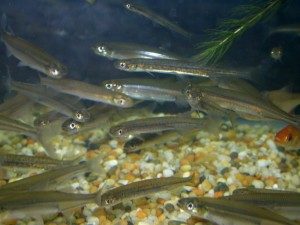Hamilton BioBlitz
Hamilton BioBlitz 2006
BioBlitz will involve about 40 scientists working from a temporary laboratory at the Museum, fitted with displays, microscopes and computers, to discover all different kinds of life-from birds to bugs, fish to fungi, plants to parasites-that live in the land around the riverbank behind the museum, in the Waikato river and Parana Park. Last year BioBlitz was held in the Auckland Domain when over 1,700 species were identified.
More info about BioBlitz in Hamilton City 2006
Report on the Species found and identified at BioBlitz Hamilton 10-11 November 2006.
 An expert team of over 30 scientists from The University of Waikato, NIWA, Landcare Research, AgResearch, WINTEC, Department of Conservation and Environment Waikato spent 24 hours searching along the riverbank and in the Waikato River between the Victoria and Claudelands bridges and surrounding streams near the Waikato Art Museum for species.
An expert team of over 30 scientists from The University of Waikato, NIWA, Landcare Research, AgResearch, WINTEC, Department of Conservation and Environment Waikato spent 24 hours searching along the riverbank and in the Waikato River between the Victoria and Claudelands bridges and surrounding streams near the Waikato Art Museum for species.
The scientists focused on searching for lichen and mosses, trees and plants, fungi, bats, birds, beetle and weta, moths, butterflies, spiders, flies, wasps, bees, worms, freshwater insects, freshwater algae, aquatic plants, fish and zooplankton.
A total of 948 species were discovered.
The aim of the event was to amass data about the urban biodiversity, and to open the public’s eyes to the vast array of species with which they share the places they frequent daily. As an additional benefit, BioBlitz helps inspire youngsters to consider a future science career.
Moths and Butterflies
Fifty species of moths, but no butterflies were found. Most of the species seen were common native moths; there were also a few common introduced species. The lack of butterflies is not surprising in an urban area; only Cabbage White and Monarch might have been expected, and it was probably too cool for the former and too early in the season for the latter.
The most interesting species found was an undescribed member of the bell-moth family (Catamacta sp., family Tortricidae) whose caterpillars feed on the flowers and fruits of cabbage trees. Possibly no more than two specimens of this moth have been found in the North Island before. A lichen-feeding member of the litter moth family (Phaeosaces coarctatella; family Oecophoridae) was surprisingly common in this urban site. Introduced moth species appeared to be less abundant than one might have expected in such a modified area.
Fungi
Seventy four species of fungi were found in the study area. The recent rain meant that there were considerable numbers of fruiting fungi, including a wonderful collection of native edible fungus.
Birds
Nineteen birds: house sparrow, starling, myna, songthrush, blackbird, mallard duck, chaffinch, rock pigeon, goldfinch, greenfinch, magpie, kingfisher, pukeko, silvereye, welcome swallow, fantail, morepork, white-faced heron, grey warbler. There was nothing unusual about finding the above bird species. They are the birds that were expected to be found from previous surveys done in the area. A few birds were absent (eg yellowhammer, Californian quail, shining cuckoo, various shags and other waterfowl flying thru over the river) that are probably present at some time.
Bats
Bats were found at Hammond Park. It was not possible to tell exactly how many but more then one. A special “bat detector” that picks up the ultrasonic ecolocation calls the bats make enabled the scientists to hear and locate them.
Animal Pests
Two weeks prior to BioBlitz 10 Black Trakka tracking tunnels were set along the river between the Bridge Street and Claudelands bridges. Five tunnels were placed on either side of the river as close to even spacing as possible (approximately 250m apart), starting from the Claudelands Bridge.
On the Friday of the Bioblitz tracking papers were placed in 9 of the tracking tunnels and left overnight. 14 aniseed flavoured wax blocks were placed out along the easern side of the river and a rat trap was set under Bridge Street bridge. The tracking papers, wax blocks and trap were collected on Saturday morning.
Small mammal sign was only detected on the eastern side of the river. One tunnel was tracked by each of mice, hedgehogs and rats, and a rat was caught in the trap (next to the tunnel tracked by rats). Several possums and a hedgehog were also observed on the eastern side on Friday night.
Poisoning of possums and rats on the city side of the river may explain lack of detections there. On the eastern side, small mammals are present and appear to be locally abundant.
Zooplankton
From the zooplankton and benthic microfauna group, 35 species were found. This included a number of microscopic crustaceans (i.e., small relatives of crabs and shrimp ), including the recent North American invader Daphnia dentifera, first recorded from New Zealand in 1993. This species appeared to be the most abundant invertebrate in the river. Daphnia may compete with our native animals and may have an impact on fish populations. Most zooplankton species found were rotifers, a microscopic invertebrate group little studied in New Zealand, which typically dominate lake, pond and large river communities. Also found were a handfull of “testate amoebae”, small amoeboid protozoans that have small houses they secrete or construct from material gathered from the surrounding environment.
Weta and crickets
Four Orthoptera species were found. They included the Auckland tree weta, Black field cricket, 1 species of ground weta and 1 species of cave weta. Finding these species was expected.
Aquatic invertebrate group
43 taxa found. These were a mix of insects (including caddisflies, mayflies and stoneflies), molluscs, crustaceans, bugs and various worms. Several species were found in small streams and seeps feeding the main river.
Vascular Plants
Most of the Bioblitz plant records came from the forays of a team of botanists (Catherine Beard – Waikato University, Mark Smale and Bruce Burns – Landcare Research, Gerard Kelly – Hamilton City Council and Paul Champion – NIWA) along tracks and paths on both sides of the river and a riverside view of cliffs and inaccessible places from the NIWA boat ably skippered by Aleki Taumoepeau. Additional garden plant records came from Wynne Johns, Jan Simmons, and Gail Coles.
A total of 381 vascular plant taxa (more if you include the aquatic plant records) were found during the Bioblitz. Of these, 65 were native species (not including obviously planted ones), 116 were planted specimens (with 48 of these being native species) and 200 introduced weeds.
Although the majority of plants found were introduced, a surprising number of native species have hung on in this habitat including the trees kanuka, kamahi, mahoe and kotukutuku (tree fuchsia), cliff dwelling plants such as the sedge Machaerina sinclairii and wharariki (mountain flax) and twenty one ferns including four species of tree ferns.
There were some magnificent planted trees, including several species in the redwood family (coastal redwood, Californian big tree or Wellingtonia, dawn redwood, Chinese and American swamp cypresses), huge edible chestnuts and various North American and English oaks. Interestingly, seedlings of the oaks and chestnuts were common near the parent trees; there is obviously good pest control in Hamilton and no squirrels!
The weedy hordes contributed over 75% of the non-ornamental plant species found. Most were common garden, lawn and wasteland weeds with curious common names such as shepherds purse, pearlwort, dovesfoot, cats tongue and gypsywort. However, seventy three of the naturalised species are still commonly planted in gardens, likely to have jumped the garden fence, or were they pushed? Amongst the riverbank willows, alders and false acacias were Phoenix and Chinese windmill palms, hydrangeas, monkey apples, box elders, sycamores and numerous climbers like ivy, wisteria and even one large climbing rose scrambling over willows near the Claudelands Bridge. There was a fair amount of free food potentially on offer including a solitary tomato plant and avocado tree, Cape gooseberries, loquats, chestnuts, peaches, plums and Japanese walnuts.
Twenty plants on the new National Pest Plant Accord (species banned from sale, propagation and distribution due to their ability to naturalise, invade and displace native vegetation) were found during the Bioblitz. These included the notorious old man’s beard, fortunately uncommon in the Waikato but scattered in the Bioblitz area along the inaccessible river margins. Other NPPA plants included snow poppy, Mexican daisy, yellow flag iris and wild ginger.
Spiders (Araneae)
37 different spider species in 18 familieswere found and identified. These spiders were collected by sweep netting, pit trapping, litter sampling and hand collecting by day and night. There was a good mixture of native and introduced species which is what you would expect in a modified urban area with plantings of natives.
There were a lot of the large ground hunting spiders, these are native and are now Uliodon sp belonging to the family of spiders called Zoropsidae. We found lots of tiny crab spiders and a lot of the common orbweb spiders. We also found two special yellow orbweb type spiders which we could not identify as they are not yet mature. We are keeping them alive and will raise these to maturity over the next month.
Bees, Wasps and Ants
Trapping was carried out for the two weeks preceding the event, using pitfall traps and Flight Intercept Traps. Individuals were also sampled over the 24 hr period of the event by beating, pooters and observation. A total of 20 species of Hymenoptera were sampled from various groups.
Vespid wasps, Bumble Bees, Honey Bees and Spider Hunting Wasps and several species of ants were present. Nothing unusual was collected but the total abundance of Hymenoptera was slightly lower than expected, possible reflecting the cooler temperatures in the days preceding the event.
Flies
The BioBlitz zone was found to be singularly barren for a range of fly species. Forty nine species were found of common flies. In a net sweep late in the morning of the second day a more uncommon species was found.
Aquatic plants
The aquatic plant team found a total of 16 species. Nine native aquatic plant species:
Glossostigma cleistanthun, Glossostigma elatinoides, Lilaeopsis novae-zealandiae, Limosella lineata, Myriophyllum triphyllum, Azolla rubra, Lemna minor, Callitriche petriei, Crassula sinclarii.
Seven invasive aquatic plant species:
Ceratophyllum demersum (hornwort), Egeria densa, Potamogeton crispus,
Callitriche stagnalis, Ludwigia palustris, Nasturtium officinale, Apium
nodi-florum
The plants and fish indicated a good productive diverse habitat.
Aquatic Algae
We found 81 species. It was the range of species found that was interesting and the fact that 9 species of cyanobacteria (Blue-green algae) were found that are associated with toxin production (Please note that these were at low levels, below health guidelines).
Nematodes
The Nematology team collected samples of soil beneath native plants, lawn and from the Waikato river bed at Parana Park. Plants sampled were: rangiora, cabbage tree, flax, totara, astelia and ferns. Nematodes were also received from plankton net samples.
Nematodes were extracted from soil by a rapid, qualitative sieving and centrifugation method. Thirty-eight taxa of nematodes were identified in the 24 hour period, all identified from adult specimens. The taxa included genera of plant, bacterial, fungal, predatory and omnivorous feeding types. We observed what can be considered ‘native’ plant feeding fauna beneath the native plants, such as ring (Criconema, Ogma), sheath (Hemicycliophora), dagger (Xiphinema) as well as large insect parasitic (Mermithidae) nematodes. Soil from beneath lawned areas yielded many bacterial feeding nematodes.
Fish
Scientists discovered sixteen species including short-finned eels, one native crayfish (or koura), shrimps, perch and smelt in the Waikato River. A number of pest fish species were caught including koi carp (which can grow to over a metre in length and can also make the water become very cloudy) and mosquito fish.
Click on the buttons below to view files.
How organisms are found file
How scientists find stream and river life file
- Aquatic plants – 16
- Beetles – 46
- Birds – 19
- Bugs – 17
- Fish – 16
- Flies – 49
- Freshwater algae – 82
- Freshwater invertebrates – 43
- Fungi – 74
- Lichens – 8
- Lizards and Frogs Did not search
- Mammals (bats & exotics) – 5
Molluscs (terrestrial) – 3 - Mosses, liverworts and hornworts – 10
- Moths / butterflies – 50
- Nematodes – 38
- Spiders – 37
- Vascular plants – 382
- Wasps, bees and ants – 14
- Weta – 4
- Zooplankton/Protozoa – 35
Join the Forum
Any individual, community group or organisation interested and committed to protecting and restoring biodiversity can be a member of the Forum. It is free to join. You will get an invite to Forum events and receive information on biodiversity workshops, useful biodiversity information, access to other members for sharing knowledge and ideas and help with restoration projects. So contact us and become a member for no cost.

